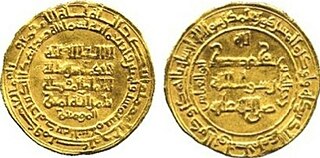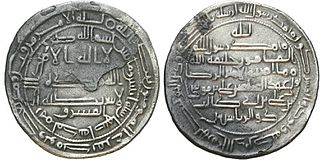Related Research Articles

The Abbasid Caliphate or Abbasid Empire was the third caliphate to succeed the Islamic prophet Muhammad. It was founded by a dynasty descended from Muhammad's uncle, Abbas ibn Abd al-Muttalib, from whom the dynasty takes its name. They ruled as caliphs for most of the caliphate from their capital in Baghdad in modern-day Iraq, after having overthrown the Umayyad Caliphate in the Abbasid Revolution of 750 CE (132 AH). The Abbasid Revolution had its origins and first successes in the easterly region of Khorasan, far from the bases of Umayyad power in Syria and Iraq. The Abbasid Caliphate first centered its government in Kufa, modern-day Iraq, but in 762 the caliph Al-Mansur founded the city of Baghdad, near the ancient Babylonian capital city of Babylon and Persian city of Ctesiphon. Baghdad became the center of science, culture, and invention in what became known as the Golden Age of Islam. This, in addition to housing several key academic institutions, including the House of Wisdom, as well as a multiethnic and multi-religious environment, garnered it an international reputation as the "Centre of Learning".
The Nezamiyeh or Nizamiyyah are a group of institutions of higher education established by Khwaja Nizam al-Mulk in the eleventh century in Iran. The name nizamiyyah derives from his name. Founded at the beginning of the Seljuk Empire, these Sunni Islam theological schools are considered to be the model of later Islamic universities, or schools.

The Buyid dynasty, also spelled Buwayhid, was a Zaydi and, later, Twelver Shia dynasty of Daylamite origin, which mainly ruled over Iraq and central and southern Iran from 934 to 1062. Coupled with the rise of other Iranian dynasties in the region, the approximate century of Buyid rule represents the period in Iranian history sometimes called the "Iranian Intermezzo".

Abū ʾl-Qāsim al-Faḍl ibn al-Muqtadir, better known by his regnal name of al-Mutīʿ li-ʾllāh, was the Abbasid caliph in Baghdad from 946 to 974, ruling under the tutelage of the Buyid emirs.

Abu'l-Abbas Ahmad ibn Ishaq, better known by his regnal name al-Qadir, was the Abbasid caliph in Baghdad from 991 to 1031. He was the nephew of al-Muti', and was chosen in place of the deposed caliph, at-Ta'i, his cousin. His reign was marked by the strengthening of the Abbasid caliphate's role as the champion of Sunni Islam against Shia Islam, notably through the Baghdad Manifesto of 1011, and through the codification, for the first time, of Sunni doctrines and practices in the Risāla al-Qādiriyya, thereby presaging the "Sunni Revival" later in the century.

Abū Ja'far Abdallah ibn Aḥmad al-Qādir, better known by his regnal name al-Qā'im bi-amri 'llāh or simply as al-Qā'im; 8 November 1001 – 3 April 1075), was the Abbasid caliph in Baghdad from 1031 to 1075. He was the son of the previous caliph, al-Qadir. Al-Qa'im's reign coincided with the end of the Buyid dynasty's dominance of the caliphate and the rise of the Seljuk dynasty.

Abū'l-Qasim ʿAbd Allāh ibn Muhammad ibn al-Qa'im better known by his regnal name Al-Muqtadi was the Abbasid caliph in Baghdad from 1075 to 1094. He succeeded his grandfather caliph al-Qa'im in 1075 as the twenty-seventh Abbasid caliph.
Abu'l-Abbas Ahmad ibn Abdallah al-Muqtadi usually known simply by his regnal name Al-Mustazhir billah was the Abbasid Caliph in Baghdad from 1094 to 1118. He succeeded his father al-Muqtadi as the Caliph. The main and important events during his reign are; appearance of the First Crusade in Western Syria, Muslim protest in Baghdad against crusaders, His efforts to help Mawdud to organized several expeditions to reconquer lands from the Crusaders.
Hajib or hadjib was a court official, equivalent to a chamberlain, in the early Muslim world, which evolved to fulfil various functions, often serving as chief ministers or enjoying dictatorial powers. The post appeared under the Umayyad Caliphate, but gained in influence and prestige in the more settled court of the Abbasids, under whom it ranked as one of the senior offices of the state, alongside the vizier. From the early caliphates, the post spread to other areas under Muslim dominion: in al-Andalus the hajib was always superior to the vizier and by the 10th century had come to wield enormous power as a de facto chancellor; in the eastern dynasties, the Samanids, Buyids and Ghaznavids, the title acquired a mainly military role; under the Seljuks, Ilkhanids and Timurids it reverted to its role as a court official; in Fatimid Egypt, the chief hajib, styled sahib al-bab or hajib al-hujjab was also an important official; under the Mamluks, they acquired important judicial duties.

Rukn al-Din Abu'l-Muzaffar Berkyaruq ibn Malikshah, better known as Berkyaruq (برکیارق), was the fifth sultan of the Seljuk Empire from 1094 to 1105.
The Seljuk Empire, or the GreatSeljuk Empire, was a high medieval, culturally Turko-Persian, Sunni Muslim empire, established and ruled by the Qïnïq branch of Oghuz Turks. It spanned a total area of 3.9 million square kilometres from Anatolia and the Levant in the west to the Hindu Kush in the east, and from Central Asia in the north to the Persian Gulf in the south.

Abbasid architecture developed in the Abbasid Caliphate between 750 and 1227, primarily in its heartland of Mesopotamia . The great changes of the Abbasid era can be characterized as at the same time political, geo-political and cultural. The Abbasid period starts with the destruction of the Umayyad ruling family and its replacement by the Abbasids, and the position of power is shifted to the Mesopotamian area. As a result there was a corresponding displacement of the influence of classical and Byzantine artistic and cultural standards in favor of local Mesopotamian models as well as Persian. The Abbasids evolved distinctive styles of their own, particularly in decoration. This occurred mainly during the period corresponding with their power and prosperity between 750 and 932.

The Zumurrud Khatun Mosque and Mausoleum, also known as the Tomb of Sitta Zubayda, is a historic mosque and shrine located in Baghdad, Iraq. It dates back to the Abbasid era. It is located in Sheikh Maarouf Cemetery in the Karkh side of Baghdad, and the site was built at the patronage of Zumurrud Khatun and her son. Zumurrud Khatun was the wife of the 33rd Abbasid caliph, al-Mustadi and mother of Caliph al-Nasir. She collected the waqf money from madrasas and built her mausoleum before her death, which is located in Karkh.
By the late 11th century, the Shi'a sub-sect of Ismailism had found many adherents in Persia, although the region was occupied by the Sunni Seljuk Empire. The hostile tendencies of the Abbasid–Seljuk order triggered a revolt by Ismailis in Persia under Hassan-i Sabbah. Siege of Maysaf
The Banu Ammar were a family of Shia Muslim magistrates (qadis) who ruled the city of Tripoli in what is now Lebanon from c.1065 until 1109.
The Shi'a Century or Shi'ite Century is a historiographical term sometimes used to describe the period between 945 and 1055, when Shi'a Muslim regimes, most notably the Fatimids and the Buyids, held sway over the central lands of the Islamic world.

Wali al-Ahd is the Arabic and Islamic term for a designated heir of a ruler, or crown prince.
Sabuktakin or Sübüktegin was a Turkic commander in the service of the Buyid dynasty. His power was such that he defied the Buyid ruler Bakhtiyar Izz al-Dawla, and even rose in revolt against him in 974, seizing control of Baghdad and threatening to overthrow Buyid rule in Iraq completely. His career was cut short by his own death in late 974. His successor, Alptakin, was defeated by the Buyids and fled to Damascus, where he eventually joined the Fatimids.
References
- ↑ Marks 2010, p. 168.
- 1 2 Berkey 2003, p. 189.
- ↑ Chaney 2016.
- ↑ Tabbaa 2011, pp. 13–14.
- 1 2 Griffel 2006, p. 782.
- ↑ Kennedy 2004, pp. 239–240.
- ↑ Tabbaa 2017, p. 308.
- 1 2 Azzam 2016.
Works cited
- Azzam, Abdel Rahman (2016). "Sources of the Sunni Revival: Nizam u-Mulk and the Nizamiyya: An 11th-Century Response to Sectarianism". The Muslim World. 106 (1): 97–108. doi:10.1111/muwo.12126.
- Berkey, Jonathan P. (2003). The Formation of Islam: Religion and Society in the Near East, 600–1800 . Cambridge University Press.
- Chaney, Eric (2016). Religion and the Rise and Fall of Islamic Science (PDF) (Dissertation chapter). Harvard University.
- Griffel, Frank (2006). "Sunni Revival". In Meri, Josef W. (ed.). Medieval Islamic Civilization: An Encyclopedia. New York and London: Routledge. pp. 782–783. ISBN 978-0-415-96690-0.
- Kennedy, Hugh (2004). The Prophet and the Age of the Caliphates: The Islamic Near East from the 6th to the 11th Century (Second ed.). Harlow: Longman. ISBN 978-0-582-40525-7.
- Marks, Laura U. (2010). Enfoldment and Infinity: An Islamic Genealogy of New Media Art. MIT Press.
- Tabbaa, Yasser (2011). The Transformation of Islamic Art during the Sunni Revival. University of Washington Press.
- Tabbaa, Yasser (2017). "The Resurgence of the Baghdad Caliphate". In Finbarr Barry Flood; Gülru Necipoğlu (eds.). A Companion to Islamic Art and Architecture, Vol. 1: From the Prophet to the Mongols. Wiley-Blackwell. pp. 307–326.